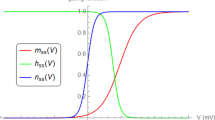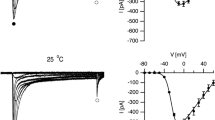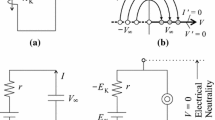Summary
The behavior under voltage clamp conditions of a coupled kinetic scheme for the sodium channel is examined. The scheme is given diagrammatically by: tano Numerical simulations are presented which show that this model fits the voltage clamp data which are well described by the Hodgkin-Huxley equations, but also gives the sorts of behavior anomalous to the Hodgkin-Huxley model which have been seen experimentally. Further, straightforward changes in parameter values are shown to be capable of mimicking the ways in which some axonal preparations differ from others. Detailed, but admittedly heuristic, arguments are presented for the propositions that: 1) the model is minimal; i.e. no simpler kinetic model will fit the array of data simulated, and: 2) the transient excited state is necessary; i.e. no model of comparable simplicity with pure voltage dependent kinetics will fit the array of data simulated.
Similar content being viewed by others
References
Armstrong, C. M.: Comparison of g Kinactivation caused by quaternary ammonium ion with g Nainactivation. Biophys. J. 10, 185a (1970)
Chandler, W. K., Hodgkin, A. L., Meves, H.: The effect of changing the internal solution on sodium inactivation and related phenomena in giant axons. J. Physiol. 180, 821 (1965)
Chiu, S. Y.: Observations on sodium channel inactivation in frog nerve. Biophys. J. 16, 25a (1976)
Connor, J. A.: Sodium current inactivation in crustacean axons. Biophys. J. 16, 24a (1976)
Eigen, M.: New looks and outlooks on physical enzymology. Quart. Rev. Biophys. 1, 3 (1968)
Goldman, L.: Quantitative description of the sodium conductance of the giant axon of Myxicola in terms of a generalized second-order variable. Biophys. J. 15, 119 (1975)
Goldman, L., Hahin, R.: Interpretation of a coupled activation-inactivation model for the g Na. Abstracts of the Fifth International Biophysics Congress, Copenhagen. International Union for Pure and Applied Biophysics, 1975
Goldman, L., Shauf, C. L.: Quantitative description of sodium and potassium currents and computed action potentials in Myxicola giant axons. J. Gen. Physiol. 51, 361 (1973)
Hodgkin, A. L., Huxley, A. F.: A quantitative description of membrane current and its application to conduction and excitation in nerve. J. Physiol. 117, 500 (1952)
Hoyt, R. C.: Sodium inactivation in nerve fibers. Biophys. J. 8, 1074 (1968)
Hoyt, R. C., Adelman, W. J.: Sodium inactivation: Experimental test of two models. Biophys. J. 10, 610 (1970)
Jakobsson, E.: The physical interpretation of mathematical models for sodium permeability changes in excitable membranes. Biophys. J. 13, 1200 (1973)
Jakobsson, E.: An assessment of a coupled three-state kinetic model for sodium conductance changes. Biophys. J. 16, 291 (1976)
Jakobsson, E., Scudiero, C.: A transient excited state model for sodium permeability changes in excitable membranes. Biophys. J. 15, 577 (1975)
McQuarrie, D. A., Mulas, P.: Asymmetric charge distributions in planar bilayer systems. Biophys. J. 17, 103 (1977)
Moore, J. W., Cox, E. B.: A kinetic model for the sodium conductance system in squid axon. Biophys. J. 16, 171 (1976)
Oxford, G. S., Pooler, J. P.: Selective modification of sodium channel gating in lobster axons by 2,4,6-trimtrophenol. Evidence for two inactivation mechanisms. J. Gen. Physiol. 66, 765 (1975)
Peganov, E. M.: Kinetics of sodium channel inactivation in the frog Ranvier node. Bull. Exp. Biol. Med. 76, 1254 (1973)
Rothman, J. E., Lenard, J.: Membrane asymmetry. Science 195, 743 (1977)
Rawlings, P. K., Neumann, E.: Physical-chemical approach to the transient change in Na ion conductivity of excitable membranes. PNAS 73, 4492 (1976)
Schauf, C. L.: Sodium currents in Myxicola axons. Nonexponential recovery from the inactive state. Biophys. J. 14, 151 (1974)
Schauf, C. L.: Comparison of two-pulse sodium inactivation with reactivation in Myxicola giant axons. Biophys. J. 16, 245 (1976)
Author information
Authors and Affiliations
Rights and permissions
About this article
Cite this article
Jakobsson, E. A fully coupled transient excited state model for the sodium channel. J. Math. Biology 5, 121–142 (1978). https://doi.org/10.1007/BF00275895
Received:
Revised:
Issue Date:
DOI: https://doi.org/10.1007/BF00275895




